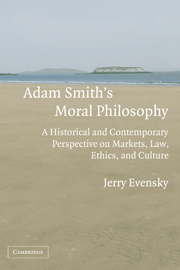 Adam Smith's Moral Philosophy
Adam Smith's Moral Philosophy Book contents
- Frontmatter
- Contents
- Preface
- Adam Smith's Moral Philosophy
- PART ONE ON ADAM SMITH'S MORAL PHILOSOPHICAL VISION
- PART TWO ON THE PLACE OF THE WEALTH OF NATIONS IN ADAM SMITH'S MORAL PHILOSOPHICAL VISION
- PART THREE ON ADAM SMITH'S MORAL PHILOSOPHICAL VISION AND THE MODERN DISCOURSE
- Epilogue: On the Human Prospect
- References
- Index
Preface
Published online by Cambridge University Press: 11 November 2009
- Frontmatter
- Contents
- Preface
- Adam Smith's Moral Philosophy
- PART ONE ON ADAM SMITH'S MORAL PHILOSOPHICAL VISION
- PART TWO ON THE PLACE OF THE WEALTH OF NATIONS IN ADAM SMITH'S MORAL PHILOSOPHICAL VISION
- PART THREE ON ADAM SMITH'S MORAL PHILOSOPHICAL VISION AND THE MODERN DISCOURSE
- Epilogue: On the Human Prospect
- References
- Index
Summary
The realization of this book has been a long labor of love.
I began this research program in a graduate History of Economic Thought class taught at Syracuse University by Jesse Burkhead. Our interest piqued, Jesse offered a sequel to a small group of us. In that latter class, I focused on Adam Smith. I read, reflected, wrote, and through that process I began to develop a hypothesis regarding Adam Smith's moral philosophy and its relationship to the modern discourse. My commitment to the project grew and, with Jesse as my advisor, I wrote a dissertation titled “Expanding the neoclassical vision: a proposal for recapturing the lost legacy of Adam Smith.”
With that graduate student beginning as a point of departure, my subsequent efforts have involved a constant process of iterative hypothesis development: refining my hypothesis regarding the logic of Smith's moral philosophy on one track, and on another developing my understanding of how that first track informs a constructive critique of the modern discourse in economics and its relationship to the larger domains of social science and social philosophy.
My ideas have evolved as follows. At every stage, I challenged my extant hypothesis regarding Smith's moral philosophy by reading and reflecting, always asking myself: Is it consistent with the original Smith texts, with what I've learned from the secondary literature on Smith, with Smith's historical context? As I challenged my hypothesis, new ideas emerged that changed or complemented that hypothesis.
- Type
- Chapter
- Information
- Adam Smith's Moral PhilosophyA Historical and Contemporary Perspective on Markets, Law, Ethics, and Culture, pp. xi - xviPublisher: Cambridge University PressPrint publication year: 2005
